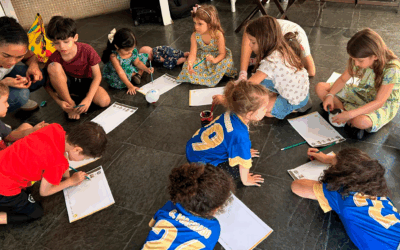 Loppiano’s Auditorium was packed last October 3, in an atmosphere of great expectations. On the agenda was an evening dialogue on “Augustine of Hippo: a legacy and a resource,” inserted within the framework of the fifth edition of LoppianoLab, promoted by the Sophia University Institute (IUS) and Citta’ Nuova Publishing House, and emceed by Marco Tarquinio, Director of Avvenire, the main Catholic paper in Italy. Onstage were two “top advocates of Italian creative thought,” according to New City’s Director, Sophia University, theologian and philosopher, Piero Coda. This was really “an extraordinary lesson” offered within a perspective of dialogue and enriched by stimulating questions addressed by the students regarding the actuality of the philosophy of this “gigantic” figure of the Church and of philosophy. Despite the different profiles of the two main guests and the outstanding diversity between their evaluations of the works of the Bishop of Hippo, what occurred was not so much a rhetoric duel or even an abstract confrontation detached from daily life, but rather, a remarkable outcome which the art of dialogue is able to produce when knowledge and sharing intertwine in a clear action, open to the light of truth. The philosopher, Galimberti, gave the Bishop of Hippo credit for having introduced into western culture the concept of the individual person, underlining the dualism of body/soul, as inspired by a religion such as Christianity which assigns a central value to self reflection on one’s own corporeal existence (“And the Word was made flesh”, wrote John in the prologue of his Gospel). Piero Coda, on the other hand, defined Augustine as the person who “discovered interiority” in the Christian perspective. Interiority is seen as the inner space where man encounters God, and reaches total fulfillment as a bodily and spiritual being, as conveyed in the expression, “withdrawing inwards… so as to transcend also oneself,” which is the starting point of Augustine’s reflections, without however isolating oneself in a blind introspection but in order to perceive also what lies beyond ourselves.” Augustine’s interiority is inhabited by Christ and therefore by the relationship with the other: and this where the discussion faces the concept of “relationships,” since God reveals Jesus Christ, who in turn speaks of God as a father and attests to the universal bond of brotherhood. The third concept which clearly emerged was that of the “city” given that precisely Augustine wrote “De Civitate Dei,” a work that deals with the image of a city which embraces people of all beliefs, open to the quest for a common good rooted in that Utmost Good which is God, through the life of the Gospel. Three overviews offer new meanings that can direct society today towards a fuller integration. Dissatisfied with the consolation of certainties, and a relentless seeker of truth, in this sense Augustine also on this occasion, has revealed to be a personage who is able to bridge the centuries and speak to the youth and adults of all latitudes. It is a landmark which guides us in our quest for the roots of the “person,” of a people, so as to better grasp the present and also work up new proposals for the future. Source: Sophia University Online
Loppiano’s Auditorium was packed last October 3, in an atmosphere of great expectations. On the agenda was an evening dialogue on “Augustine of Hippo: a legacy and a resource,” inserted within the framework of the fifth edition of LoppianoLab, promoted by the Sophia University Institute (IUS) and Citta’ Nuova Publishing House, and emceed by Marco Tarquinio, Director of Avvenire, the main Catholic paper in Italy. Onstage were two “top advocates of Italian creative thought,” according to New City’s Director, Sophia University, theologian and philosopher, Piero Coda. This was really “an extraordinary lesson” offered within a perspective of dialogue and enriched by stimulating questions addressed by the students regarding the actuality of the philosophy of this “gigantic” figure of the Church and of philosophy. Despite the different profiles of the two main guests and the outstanding diversity between their evaluations of the works of the Bishop of Hippo, what occurred was not so much a rhetoric duel or even an abstract confrontation detached from daily life, but rather, a remarkable outcome which the art of dialogue is able to produce when knowledge and sharing intertwine in a clear action, open to the light of truth. The philosopher, Galimberti, gave the Bishop of Hippo credit for having introduced into western culture the concept of the individual person, underlining the dualism of body/soul, as inspired by a religion such as Christianity which assigns a central value to self reflection on one’s own corporeal existence (“And the Word was made flesh”, wrote John in the prologue of his Gospel). Piero Coda, on the other hand, defined Augustine as the person who “discovered interiority” in the Christian perspective. Interiority is seen as the inner space where man encounters God, and reaches total fulfillment as a bodily and spiritual being, as conveyed in the expression, “withdrawing inwards… so as to transcend also oneself,” which is the starting point of Augustine’s reflections, without however isolating oneself in a blind introspection but in order to perceive also what lies beyond ourselves.” Augustine’s interiority is inhabited by Christ and therefore by the relationship with the other: and this where the discussion faces the concept of “relationships,” since God reveals Jesus Christ, who in turn speaks of God as a father and attests to the universal bond of brotherhood. The third concept which clearly emerged was that of the “city” given that precisely Augustine wrote “De Civitate Dei,” a work that deals with the image of a city which embraces people of all beliefs, open to the quest for a common good rooted in that Utmost Good which is God, through the life of the Gospel. Three overviews offer new meanings that can direct society today towards a fuller integration. Dissatisfied with the consolation of certainties, and a relentless seeker of truth, in this sense Augustine also on this occasion, has revealed to be a personage who is able to bridge the centuries and speak to the youth and adults of all latitudes. It is a landmark which guides us in our quest for the roots of the “person,” of a people, so as to better grasp the present and also work up new proposals for the future. Source: Sophia University Online
Listen attentively
Listen attentively




0 Comments